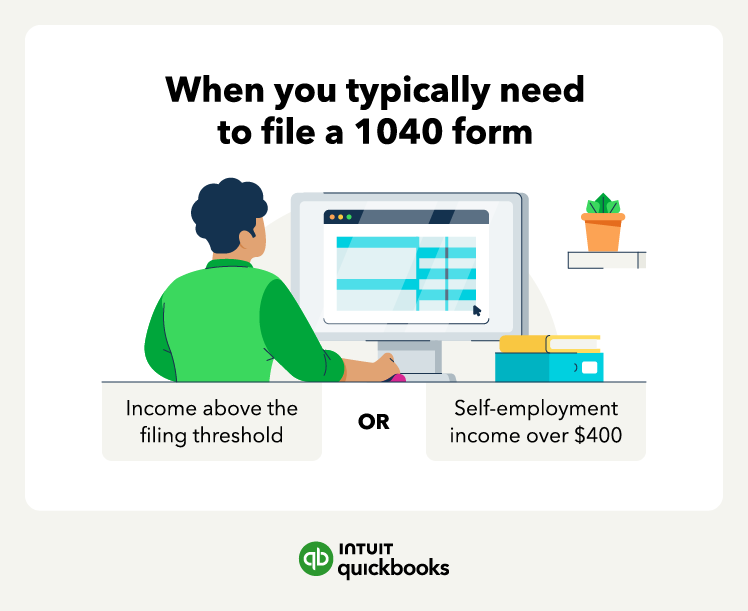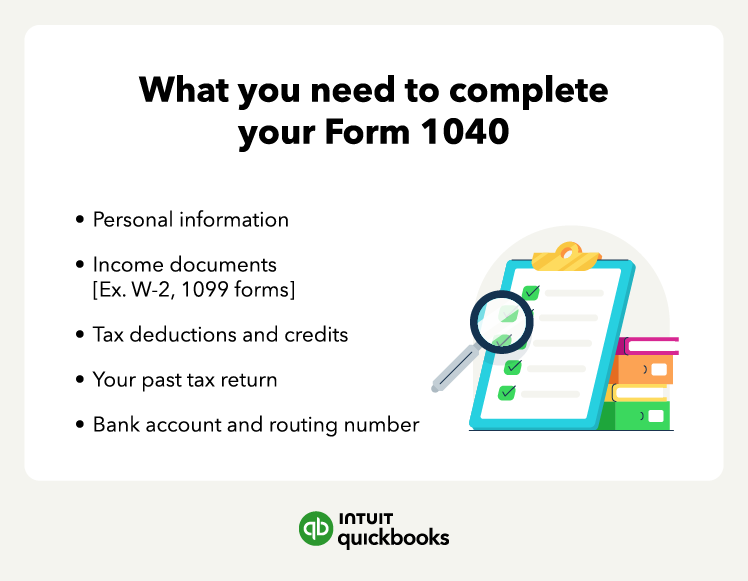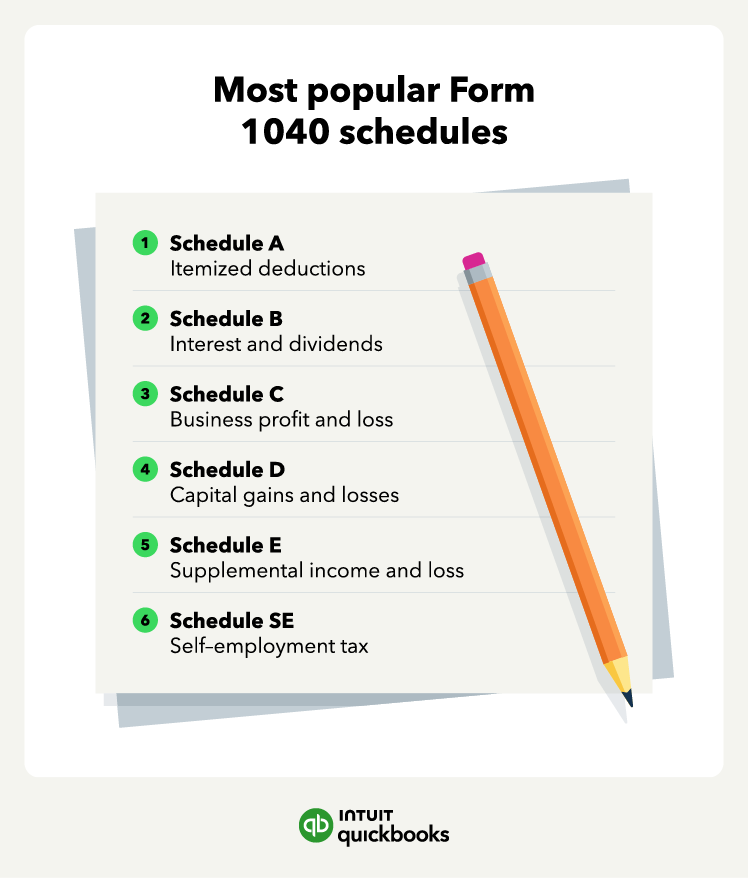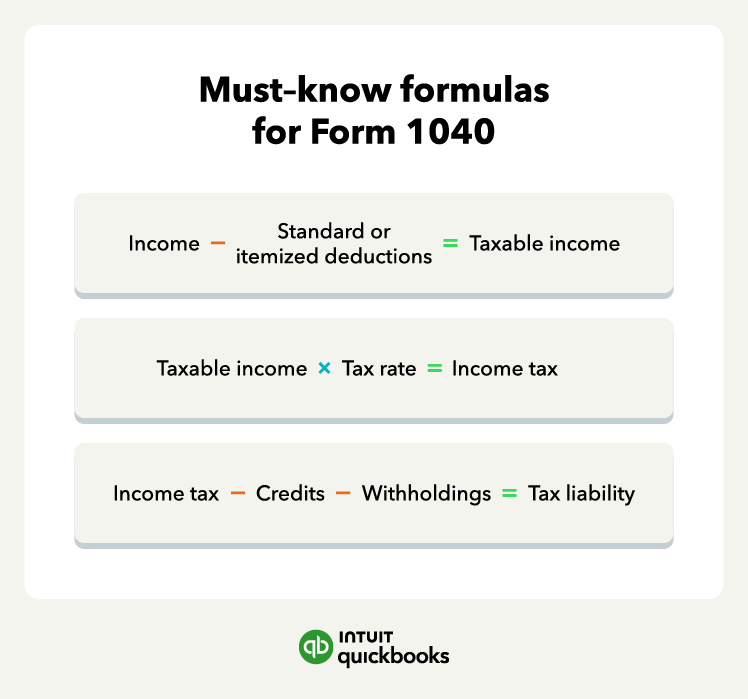 out a 1040 form." />
out a 1040 form." /> out a 1040 form." />
out a 1040 form." />
While the 1040 is one of the most common tax forms, it’s also deceptively complex. The instructions for Form 1040 are over 100 pages and can be a headache for filing sole proprietorship taxes or for small business owners trying to figure out which tax forms they need.
To guide you through the accountant jargon, let’s look at how to fill out a 1040 form step-by-step, including whether you need to file one and the schedules you might need:

If you work or earn income, you’ll likely need to file a Form 1040 . This form, also known as the US Individual Income Tax Return, is how most individuals file their taxes.
The 1040 form is a two-page document for taxpayers to determine, report, and file their income. It’s also here that taxpayers calculate their deductions and ultimately figure out how much they owe in federal income taxes.
Generally, the Form 1040 requirements require you to file a tax form for 2023 if:
 out a 1040 form." width="" />
out a 1040 form." width="" />
You can report your business income and expenses using Form 1040 if you’re self-employed, a small business owner who runs your company as a sole proprietorship, or your company is a single-member LLC . If your company is an S corporation or C corporation, you’ll need to prepare a separate corporate tax return.
To start, you’ll want to gather all your personal information, as well as several other documents. Your personal information includes your name and Social Security number for you and your spouse and any dependents.

You’ll also want to gather all your information during this step as well. Other items you’ll need include income documents like W-2 and 1099 forms , as well as proof of any tax deductions like mortgage interest or medical expense receipts.
Boxes 1-15 will be for reporting your income. Your income can include items like:
Other items that qualify as income include Social Security benefits and capital gains or losses. Box 8 of the income section includes additional income from your Schedule 1, which is a form for additional types of income that do not appear on page one of the 1040 form.
For example, Schedule 1 includes items like rent and royalty, alimony, business income or loss, income from S-corps , or unemployment.

You're never too small, and it's never too soon to know you're on track for success.
Start hereFor your 1040 form, you can either choose standard or itemized deduction. Most filers choose the standard deductions, but if you have itemized deductions that are greater than the standard deduction, you can itemize them with Schedule A.
The IRS standard deduction amount for 2023 is $13,850 if you are single or married filing separately, $27,700 for married filing jointly, or $20,800 for the head of household.
Meanwhile, itemized deductions include expenses like:
Note these are different from self-employed tax deductions , which you’ll include on your Schedule C.
Also, you may benefit from the Qualified Business Income (QBI) deduction, aka Section 199A deduction, if your business is a pass-through entity.
Taxpayers with simpler tax returns, such as those with just W-2 income and the standard deduction, will likely only need to file Form 1040. However, small business owners, self-employed individuals, and others with unique situations will likely need to file an additional schedule and attach it to their 1040 form.
Here are some of the most common schedules that you might need to append to your 1040 form:

Note that you might also need to use other schedules, such as Schedule EIC for Earned Income Credit, Schedule F for farm profit or loss, or Schedule H for household employment taxes.
Now, it’s time to calculate your tax liability. First, you’ll need your taxable income, which is your adjusted gross income minus standard or itemized deductions.

Then, use your taxable income to calculate the amount of tax you owe using the applicable tax rate from the tax tables. The tax you owe is your taxable income times the tax rate. However, this isn’t necessarily what you owe. Your tax liability is what you’ll need to pay the IRS.
The tax liability is the amount of tax you owe minus tax credits and tax withholdings. Tax credits can include items like the child tax credit, while withholdings include taxes you had withheld during the year.
While Form 1040 instructions include tax tables for calculating your tax liability, using tax software can help you automatically calculate this.
FYI: If your tax liability is negative, the IRS owes you a tax refund. If the number is positive, that’s how much you owe the government.
Now that you know how to fill out a 1040 form, it’s time to file it with the IRS. Luckily, this part is much easier than filling it out. You can file your tax forms with the IRS via mail or go paperless this tax season and file electronically.
Filing electronically, also known as e-filing, can mean you get a refund quicker, especially if you send the refund to your bank account. No matter how you file your 1040 form, the tax due date .
If your tax situation is complex, you can request a six-month extension for more time to file, but you still have to pay your tax liability by the tax due date to avoid interest charges.
Whether you fill out your 1099 and 1040 forms on your own, use software, consult an accountant, or do all three, it’s a good idea to know the tax laws. But if you don’t want to read through all the IRS instructions on how to fill out a 1040 form, there are tools to help simplify the process for you.
Consider using accounting software like QuickBooks to keep track of your expenses during the current year—making it easier for you to complete the various schedules and file your taxes accurately.
To file your Form 1040 you’ll need your personal information like name, Social Security number, as well as the names and Social Security numbers of dependents. You’ll also need income information, such as wages, self-employment income, dividends, and Social Security benefits.
What does line 16 mean on the 1040 form?Line 16 of Form 1040 is the total tax amount you owe, including tax on your taxable income, as well as tax from Form 8814 for child’s interest or dividends and Form 4972 for lump-sum distributions.
How do you fill out a 1040 form with no income?You may not need to fill out a Form 1040 if you have no income unless you meet one of the special requirements from the IRS .
Recommended for you
Ultimate guide to small business tax forms, schedules, and resources
January 25, 2024

How to calculate sales tax and avoid audits
February 11, 2021

Starting a business
How to start an e-commerce business and succeed
We provide third-party links as a convenience and for informational purposes only. Intuit does not endorse or approve these products and services, or the opinions of these corporations or organizations or individuals. Intuit accepts no responsibility for the accuracy, legality, or content on these sites.
**Product information
QuickBooks Live Assisted Bookkeeping: This is a monthly subscription service offering ongoing guidance on how to manage your books that you maintain full ownership and control. When you request a session with a Live Bookkeeper, they can provide guidance on topics including: bookkeeping automation, categorization, financial reports and dashboards, reconciliation, and workflow creation and management. They can also answer specific questions related to your books and your business. Some basic bookkeeping services may not be included and will be determined by your Live Bookkeeper. The Live Bookkeeper will provide help based on the information you provide.
QuickBooks Live Full-Service Bookkeeping: This is a combination service that includes QuickBooks Live Cleanup and QuickBooks Live Monthly Bookkeeping.
1. QuickBooks Online Advanced supports the upload of 1000 transaction lines for invoices at one time. 37% faster based off of internal tests comparing QuickBooks Online regular invoice workflow with QuickBooks Online Advanced multiple invoice workflow.
2. Access to Priority Circle and its benefits are available only to customers located in the 50 United States, including DC, who have an active, paid subscription to QuickBooks Desktop Enterprise or QuickBooks Online Advanced. Eligibility criteria may apply to certain products. When customers no longer have an active, paid subscription, they will not be eligible to receive benefits. Phone and messaging premium support is available 24/7. Support hours exclude occasional downtime due to system and server maintenance, company events, observed U.S. holidays and events beyond our control. Intuit reserves the right to change these hours without notice. Terms, conditions, pricing, service, support options, and support team members are subject to change without notice.
3. For hours of support and how to contact support, click here.
4. With our Tax Penalty Protection: If you receive a tax notice and send it to us within 15-days of the tax notice we will cover the payroll tax penalty, up to $25,000. Additional conditions and restrictions apply. See more information about the guarantee here: https://payroll.intuit.com/disclosure/.
Terms, conditions, pricing, special features, and service and support options subject to change without notice.
QuickBooks Payments: QuickBooks Payments account subject to eligibility criteria, credit, and application approval. Subscription to QuickBooks Online required. Money movement services are provided by Intuit Payments Inc., licensed as a Money Transmitter by the New York State Department of Financial Services. For more information about Intuit Payments' money transmission licenses, please visit https://www.intuit.com/legal/licenses/payment-licenses/.
QuickBooks Money: QuickBooks Money is a standalone Intuit offering that includes QuickBooks Payments and QuickBooks Checking. Intuit accounts are subject to eligibility criteria, credit, and application approval. Banking services provided by and the QuickBooks Visa® Debit Card is issued by Green Dot Bank, Member FDIC, pursuant to license from Visa U.S.A., Inc. Visa is a registered trademark of Visa International Service Association. QuickBooks Money Deposit Account Agreement applies. Banking services and debit card opening are subject to identity verification and approval by Green Dot Bank. Money movement services are provided by Intuit Payments Inc., licensed as a Money Transmitter by the New York State Department of Financial Services.
QuickBooks Commerce Integration: QuickBooks Online and QuickBooks Commerce sold separately. Integration available.
QuickBooks Live Bookkeeping Guided Setup: The QuickBooks Live Bookkeeping Guided Setup is a one-time virtual session with a QuickBooks expert. It’s available to new QuickBooks Online monthly subscribers who are within the first 30 days of their subscription. The QuickBooks Live Bookkeeping Guided Setup service includes: providing the customer with instructions on how to set up chart of accounts; customized invoices and setup reminders; connecting bank accounts and credit cards. The QuickBooks Live Bookkeeping Guided Setup is not available for QuickBooks trial and QuickBooks Self Employed offerings, and does not include desktop migration, Payroll setup or services. Your expert will only guide the process of setting up a QuickBooks Online account. Terms, conditions, pricing, special features, and service and support options subject to change without notice.